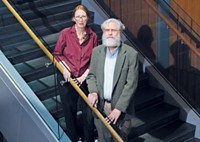Advertisement
Grab your lab coat. Let's get started
Welcome!
Welcome!
Create an account below to get 6 C&EN articles per month, receive newsletters and more - all free.
It seems this is your first time logging in online. Please enter the following information to continue.
As an ACS member you automatically get access to this site. All we need is few more details to create your reading experience.
Not you? Sign in with a different account.
Not you? Sign in with a different account.
ERROR 1
ERROR 1
ERROR 2
ERROR 2
ERROR 2
ERROR 2
ERROR 2
Password and Confirm password must match.
If you have an ACS member number, please enter it here so we can link this account to your membership. (optional)
ERROR 2
ACS values your privacy. By submitting your information, you are gaining access to C&EN and subscribing to our weekly newsletter. We use the information you provide to make your reading experience better, and we will never sell your data to third party members.
Business
Studies Assess Perceptions Of Synthetic Biology
Limited public awareness may offer companies an opportunity to shape an industry message
by Ann M. Thayer
June 24, 2013
| A version of this story appeared in
Volume 91, Issue 25
Despite the hoopla among academic researchers, do-it-yourself (DIY) scientists, start-up companies, government agencies, and nongovernmental organizations (NGOs), synthetic biology has been flying pretty much under the general public’s radar for the past five years.
It’s not as though the field’s major scientific advances—from artificial cells to the production of drugs, vaccines, and biofuels—haven’t been in the news. In response to the activity, NGOs, including ETC Group and Friends of the Earth, last year called for a moratorium on the release and commercial use of synthetic organisms until appropriate regulations and safety measures are in place. These groups kicked into higher gear this spring when they began trying to halt a crowdfunded DIY synthetic biology project to create glowing plants.
But the noise hasn’t reached the ears of the public. “We asked people if they had heard about the DIY biology movement and only 7% said they had,” says Eleonore Pauwels, a public policy scholar in the science and technology innovation program at the Woodrow Wilson International Center for Scholars. “A lot of the public is not aware of the DIY dimension, but it certainly is an important factor in the development of technology these days.”
For the past five years, Pauwels has been involved in surveying the U.S. public as part of the Wilson Center’s Synthetic Biology Project. Its most recent survey, completed in March, found that 75% of the population had heard little to nothing about synthetic biology. This awareness level is essentially flat with those for 2010 and 2009 but a sustained improvement from 89% in 2008.
What the synthetic biology field is experiencing is not much different from what’s been seen for other emerging areas, such as nanotechnology, Pauwels says. “We have seen in the past that awareness increased to a point, usually in the first five years, and then it plateaued.”
Although awareness was low, after adults received more information about synthetic biology and its potential risks and benefits, their impressions moved toward concern about the risks rather than optimism about the benefits, Pauwels explains. For example, only 15% initially said the risks outweigh the benefits, but the proportion increased to 33% once they were more informed.
That said, “applications really mattered a lot,” Pauwels says. People were very interested in, and favorable toward, synthetic biology being applied to health and the environment. They were less excited about using the technology to produce what they saw as unnecessary products. For example, 60% had a positive reaction to a synthetic flu vaccine and 51% liked the idea of engineering mosquitoes to die quickly, but only 33% saw the need to make a new food additive or sweetener.
Initial reactions may be skewed because of the combination of “synthetic” and “biology,” Pauwels says. But many people “were pretty quick to see synthetic biology as a continuum to genetic engineering.” ETC sees synthetic biology as a step too far, however, and has labeled it “extreme genetic engineering.”
By a ratio of 61% to 34%, surveyed adults said synthetic biology research should move forward rather than be banned until its implications and risks are better understood. As far as safety is concerned, the National Institutes of Health has made no distinction between recombinant and synthetic techniques under its research guidelines (C&EN, Aug. 3, 2009, page 23).
That’s not to say the public doesn’t want oversight. About 45% of adults said the federal government should regulate synthetic biology research, and 43% said government should develop voluntary research guidelines jointly with industry. These numbers are a shift from 2010 when a majority favored government oversight over industry involvement.
At 69%, “trust in scientific research is high right now,” Pauwels says, especially trust in the ability of individual researchers to maximize benefits and minimize risks associated with scientific and technological advances. “In contrast, in the 2013 survey, trust in NGOs has decreased and trust in government is extremely low.”
The findings have implications for scientists and companies wanting to push ahead in synthetic biology R&D. “Communication is always better,” and she advises that now is a good time to start thinking about how to do it effectively.
“You have to be ready when you give more information to the public to discuss it because they are going to ask questions. You have to show that you do risk research and think about long-term implications,” Pauwels adds. Although people expected the same stewardship around nanotechnology, she believes that synthetic biology will raise additional ethical and societal considerations because it involves engineering biological systems.
In the U.K., the profile of synthetic biology companies has been on the rise. In July 2012, at the request of the U.K. Department for Business, Innovation & Skills, an independent panel of experts published a synthetic biology road map for industry, academia, government organizations, funders, and others.
In April, Synthace, a 2011 spin-off of University College London focused on novel biological production systems, became one of eight founding members of a synthetic biology working group in the U.K.’s BioIndustry Association. “The working group will help us be recognized as an industry and start to have a better voice and face some common issues,” Synthace CEO Sean Ward says. Shared interests include public perception, public messaging, and policy engagement.
“We are trying to engage at the early stages here,” he says. “An important element in terms of the funding for synthetic biology in Europe, and in the U.K. in particular, has been a focus on responsible innovation, and that pretty much boils down to understanding the context in which you operate and trying to anticipate consequences.”
For instance, this may be challenging because there are regulatory unknowns that depend on the specific application of synthetic biology, Ward says. Unlike in the U.S., he adds, Europe requires a license for genetic engineering work, and therefore DIY projects usually are affiliated with a research institution or lab.
Nevertheless, whether synthetic biology takes place in a U.S. garage, European lab, or multinational company, it is presenting new ways of engineering biological systems. This, in turn, “is accelerating the need to address questions,” Ward says.





Join the conversation
Contact the reporter
Submit a Letter to the Editor for publication
Engage with us on Twitter